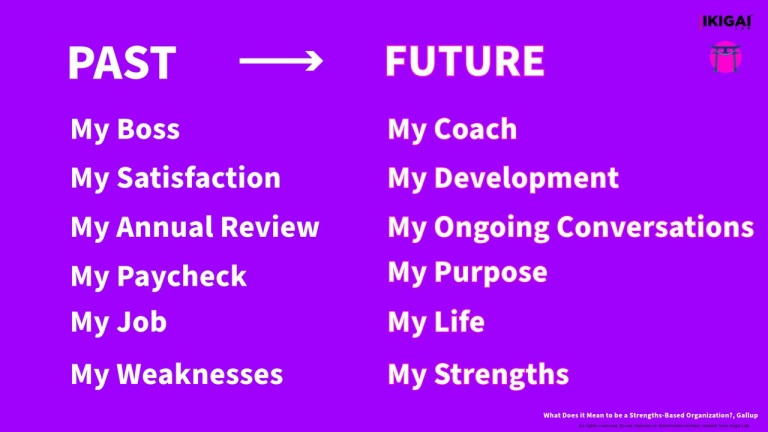In today's rapidly evolving business landscape, the intersection of leadership psychology and organizational culture plays a pivotal role in shaping business outcomes. At Envestnet’s RIA Forum, Sam Ushio, the Founder and Principal of Ikigai Lab, discussed how cultivating leadership qualities and fostering a supportive organizational culture enables businesses and their employees to grow and thrive. This approach is rooted in the Japanese concept of Ikigai, which emphasizes purpose, longevity, and productivity.
Trends in employee experience and organizational culture
Research shows employees today feel more disconnected at work and more stressed than ever before. These factors are influencing employees feel about their jobs.
Stress and the employee experience
Stress has gradually increased over the past three decades, with half of all Americans expressing that they’re frequently experiencing stress, according to Gallup data1. Stress is defined by the World Health Organization as a state of worry or mental tension caused by a difficult situation. Stress management is a hallmark of effective leadership and an important foundation within the concept of emotional intelligence.
Importance of organizational culture
Only one out of five employees in the U.S. on average feel connected to their company’s culture, according to Gallup surveys2. Cultivating a strong organizational culture is key, because employees who feel more connected to their culture are more engaged, less burned out, less likely to leave, and perform better overall2. A strong organizational culture attracts and retains clients and employees, and turns employees into brand ambassadors and clients into brand advocates.
Current state of employee engagement
Employee engagement in the U.S. has hit an 11 year low with only 30% of employees in the U.S. engaged, 53% not engaged (doing the bare minimum required), and 17% actively disengaged (actively working against the progress of the organization).3 This means an RIA with 100 employees would have 30 engaged, 53 only doing what’s necessary, and 17 working against the progress of the organization.
The business case for employee wellbeing and engagement
Having engaged employees who are connected and fulfilled pays. When Gallup compared the most highly engaged, top performing organizations to non-engaged organizations in the bottom quartile, they found that the most highly engaged organizations experienced a 23% increase in profitability, an 18% increase in sales, and a 10% increase in loyalty and engagement. Absenteeism went down in these organizations by 81%, and there was a 43% decrease in turnover.4
Oxford researchers analyzed data from 15 million employee surveys on wellbeing from the Indeed employee platform and discovered that the valuation of businesses positively correlated with work wellbeing. Companies with high wellbeing ratings typically outperformed the market, surpassing major benchmarks like the S&P 500 and the Dow Jones.5
Improving employee wellbeing
Leaders can enhance the work environment and support employee wellbeing by focusing on three key areas: meeting employees' core needs, creating a strength-based culture, and linking work to a meaningful purpose.
1) Meet employees’ core needs
Gallup’s study of more than 10,000 employees revealed that people associate trust, compassion, stability and hope with effective leaders. Employees with leaders that demonstrate these qualities feel more engaged and connected to their company and day-to-day work.6
- Trust – To employees, trust stands for honesty, integrity, and the willingness to share significant organizational decisions that may positively or negatively impact them.
- Compassion – Leaders who demonstrate compassion view employees as more than just a cog in the wheel, and are more in tune with employees’ feelings, emotions, and level of energy. Regular check-ins with employees can help leaders sync with how employees are feeling and help them manage their energy levels.
- Stability – Employees need leaders to demonstrate calmness, a sense of control, and clarity in terms of project milestones and checkpoints.
- Hope – Even in the face of disruption, we all need to see a path forward and believe that there’s something on the horizon in terms of success.
2) Create a strength-based culture
Re-engineering the employee experience and adopting certain pillars, or building blocks, can create a strong organizational culture. These pillars include moving from boss to coach, where the work relationship between managers and their employees becomes more of a coaching relationship instead of one based on command and control.

Coaching can help move employees from satisfaction to development. Another key move is putting less emphasis on annual reviews and more on ongoing conversations that happen ideally on a weekly basis. The transition from paycheck to purpose and job to life are holistic changes that have a huge impact on employees’ mindsets and wellbeing.
3) Spotlight individual purpose
The final pillar is the move from weaknesses to strengths. Instead of focusing on identifying and improving weaknesses, evidence shows that focusing on an individual’s talents increases job performance and cultural connections, drives greater business outcomes, and even more importantly, increases the life satisfaction of that employee.
Gallup has documented that organizations that focus on and invest in employees’ strengths see an increase in profit by 29%, an increase in sales by 19% and a decrease in attrition by 72%.7
As you can see, the saying that ‘people are an organization’s greatest asset’ isn’t just a phrase. The evidence actually supports it in a very meaningful way.
Embracing the psychology of leadership for RIAs
The psychology of leadership transcends traditional notions of management by focusing on empathy, empowerment, and organizational alignment. Leaders who prioritize employee wellbeing and cultivate a strong organizational culture not only foster a positive work environment, but also position their businesses for sustained growth and resilience in a dynamic marketplace.
As we navigate the complexities of modern business, embracing the principles of Ikigai and strengths-based leadership offers a pathway to achieving both individual fulfillment and collective success.
Learn more with our RIA Forum: The Psychology of Leadership: How RIAs Can Improve the Bottom Line with a Stronger Organizational Culture.
